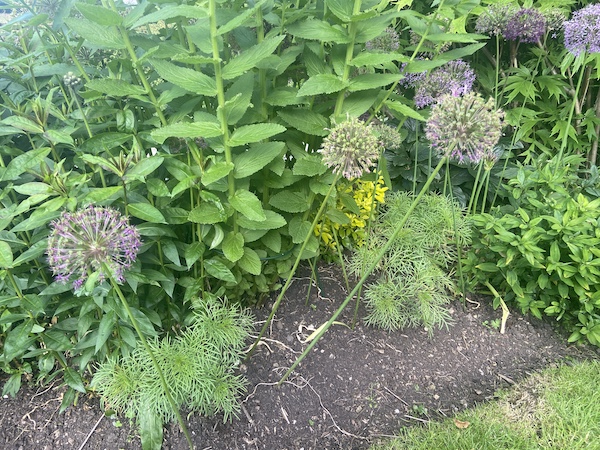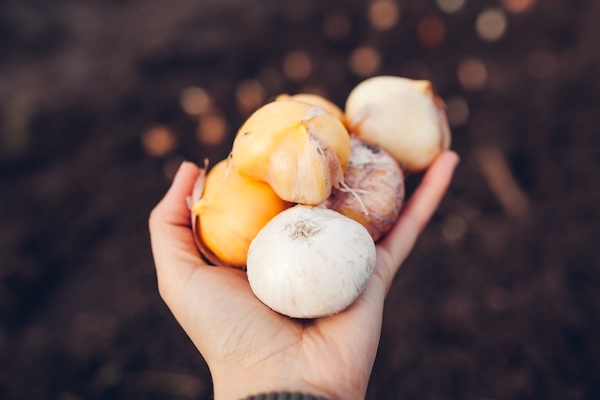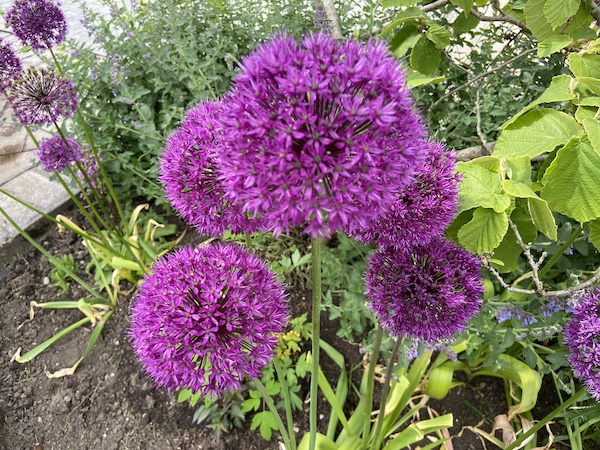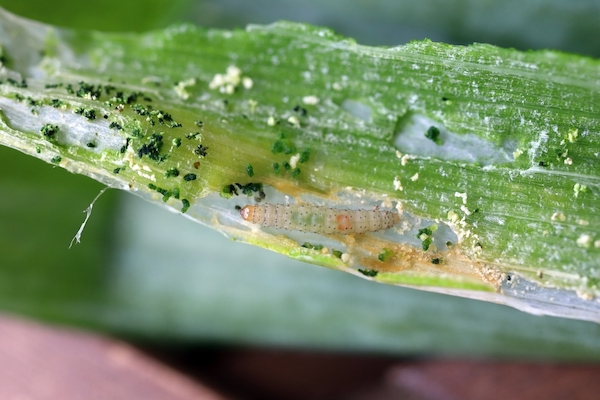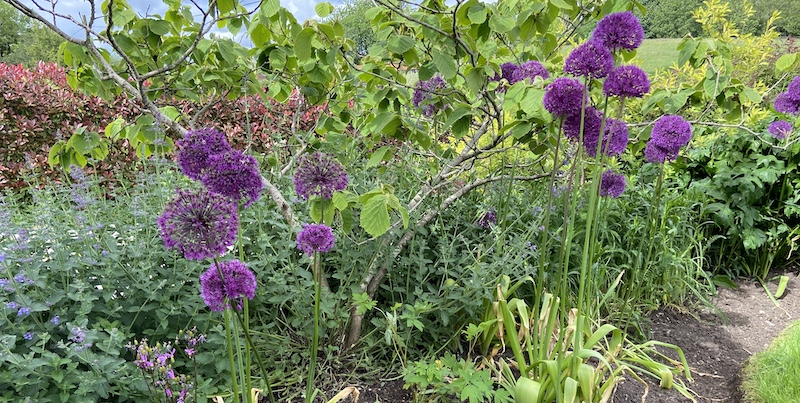
Why are my alliums not flowering?
Our site is reader supported, this means we may earn a small commission from Amazon and other affiliates when you buy through links on our site.
From personal experence, I have noticed that alliums not flowering is usually caused by problems with the bulbs themselves, what you do with them and from pests and disease. Here are the main causes of non-existent allium flowers and how to deal with them. See also When and how to plant and grow alliums for more information on how to care for your allium plants.
Allium bulbs
Small and immature bulbs
Young or small allium bulbs often do not flower until they grow larger, usually just producing foliage. Many bulbs may not flower in the first year you plant them. The smaller the bulb, the less energy and resources are available for creating flowers.
What to do
Be patient and wait until the next year when the bulbs have grown more. In the meantime, make sure the bulbs and plants receive the care and attention they need. I have also noticed that if you but cheap bulbs from cheap outlets, they are usually younger bulbs. If you buy good quality bulbs from garden centres and nurseries, they usually have large bulbs that will flower the same year. Albums bulbs can be expensive but you get what you pay for.
Bulbs stored too long
Allium bulbs can be successfully grown if they have been stored for up to 12 months. Any longer time in storage than this may result in flowers not appearing the first year you plant them, or even at all. The quality of the bulb deteriorates over time. I found this out the hard way when I moved house and waited too long before I planted the bulbs I lifted and brought with me.
What to do
If you buy the bulbs from a garden centre, remember that they may have been stored there already so plant them as soon after you purchase them as you can. Store your own allium bulbs in a cool place, such as the garage, so they can experience dormancy over the winter. Make sure they don’t freeze in the winter or heat up too much in the summer. Personally, I usually just leave them in the ground and they do well.
Growing environment
Slow draining soil
Alliums aren’t all that fussy about their growing environment. However, they will rot in poor draining soil. This causes people to be unhappy with their alliums not flowering and often they won’t even grow at all the following season.
What to do
Make sure your soil isn’t heavy or compacted clay, or naturally boggy soil. The best soil is one that is gritty with a significant dose of multi-purpose compost.
I usually improve poor draining soil with plenty of grit and compost, grit or perlite. If this isn’t possible then plan to dig up the allium bulbs in the fall and move them to a location and soil better suited to them. Ideally, you want to be improving the soil before you plant them.
Full shade
As I’ve noted, alliums aren’t too difficult to grow. However, they do prefer a good six hours of direct sunshine. They’re OK with partial shade but won’t flower in full or mostly shaded places. The best sunshine for these plants is 6 hours of morning sun and then shade in the afternoon so they don’t overheat or burn in the hottest part of the day.
What to do
If possible, remove any structures that are shading the plants. Failing this, plan to dig up the bulbs in the autumn and transplant them to a sunnier spot.
What you’ve been doing
Planted at the wrong time
The best time to plant or transplant allium bulbs is in the autumn. Anytime from September through to before the first frost will work. The ground is still warm at this time. Any later than this runs the risk of the bulb rotting in the ground over the winter. This takes away its ability to flower in the spring time.
What to do
Plant allium bulbs in the autumn. If necessary, store them in a cool place until this time.
You could plant the alliums in the spring. However, the bulbs may spend all their energy and nutrient resources on settling into their new environment rather than in developing the flowers. This is one reason why the plant doesn’t produce flowers. That being said, I have planted many good sized allium bulbs in spring and they have done really well.
Planted at the wrong depth
The flowering ability of an allium relates to its planting depth. Planting them too shallowly makes them vulnerable to winter frosts; planting them too deeply makes it difficult for them to make their way up through the ground to the surface. Both of these cases result in the plant not flowering.
What to do
Plant young, immature allium bulbs relatively shallowly. More mature bulbs can go into the ground at a deeper level. I find that the best planting depth is around three to four times the depth of the bulb.
Overcrowding the plants
Alliums like to have some space around them. Putting a mass of them into a small space forces them to compete for sunlight, water and nutrients. A lack of any of these elements can result in minimal or no flowers in the growing season.
What to do
I usually space my alliums around 20cm apart so they have plenty of space and remember some of the larger flower varieties need lots of space at their flowers can be 20cm across. If your bed of these plants looks crowded, this could be the reason that they’re not flowering. Plan to dig up a few in the autumn for transplanting elsewhere to ease the overcrowding.
Cutting back foliage after blooming
Alliums bloom only once during the growing season. After the flowers have faded, you’re left with a long stalk and wispy bits on top. If, during the previous year, you cut the foliage back at this time, your plants may not have received the right elements for flowering this year. Yes, your bed of flowers looked nice and tidy, but the bulbs lost opportunities for absorbing sunlight through photosynthesis through the leaves. They may not have stored enough energy and nutrients to enable them to generate flowers this year. This goes for most bulbs, its important to leave the foliage in place and let it die back naturally.
What to do
Deadhead the flowers after they’ve reached their peak to tidy things up a bit. This also stops the plant from wasting energy on seeds. Leave all the foliage in place until your garden clean-up in the late autumn or early winter.
Diseases and pests
Onion white rot
This is a fungal disease that’s very difficult to treat. The organisms that create this disease can lie harmlessly in the soil for years before they pop up and cause havoc to your plants. You can see the effects of this disease in wilting, yellowed leaves and the decay (rot) of the roots and bulbs. White fungal growth then appears on the base of the bulb. It shows up in mid-summer through early autumn.
What to do
Make sure to sterilise any tools that you use in the affected area so you don’t carry the disease to another part of your garden. There are no chemicals available to treat onion white rot. Remove and burn the affected plants and bulbs. Its not worth the risk of spreading the disease.
Bear in mind that the fungus can remain in the soil for at least 15 years and can infect whatever else you plant there so you may want to look for alternative plants to plant there.
Allium leaf miner
This is a fly that was first found in the UK in 2002. It spread widely in England and parts of Wales. At the start of the infestation, the adult fly makes punctures in the leaves to feed on the sap, You may see a line of white dots on the foliage at this time. They then lay their eggs.
After hatching, the larvae/maggots work their way into the foliage, stems and bulbs of the plants in the allium family. You may see these brown larvae embedded in the leaves.
The problem becomes more obvious when the plant starts rotting from secondary infections. All this damage deteriorates the health of the plant, prohibiting it partially or fully from flowering.
What to do
There’s no chemical solution to the problem of allium leaf miners. Prevention, to some extent, is possible by covering the plants with an insect-proof mesh when the adult flies are laying the eggs. This is usually in March to April, and September to November.
